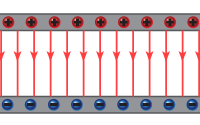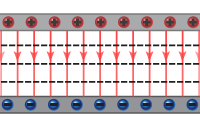|
Electric potential energy refers to the energy stored in a charged particle when you move that particle into a particular location. Electric potential is the electric potential energy per unit charge, and it has units of volts (one volt being one joule per coulomb). Equipotential lines trace regions of equal electric potential, much as contour lines trace regions of equal elevation on topographic maps. A capacitor is an electrical component that can store a certain amount of electric charge per volt applied to it; the amount of stored charge is proportional to the applied voltage and the capacitance. 
|
|
electric potential, equipotential, electric potential energy, capacitor, capacitance
|
|
|
|
Review problems and questions |
|

- Which of the following diagrams could be applied to a fully charged 1.5 V battery? (More than one selection may be correct.)

 |
Choices (b) and (c) are both permissible. By definition, the electric potential of a 1.5 V cell’s positive (+) terminal is 1.5 V higher (more positive) than its negative (−) terminal. The electric potential of the negative terminal, by itself, is arbitrary (though it often is set to zero for convenience). Only choices (b) and (c) have positive terminals that are 1.5 V above their negative terminals. 
|

- Charge 1 (with q1 coulombs) generates the electric field shown here. Charge 2 (with q2 coulombs) is brought to a distance r from Charge 1.
- How would doubling q1 affect the electric potential energy Ep?
- What about doubling q2?
- How about doubling both charge values?
- Finally, what about doubling the distance, r?

 |
Answer: - Doubling q1 will double the electric potential energy Ep.
- Doubling q2 will likewise double the electric potential energy Ep.
- Doubling both charge values will quadruple the electric potential energy.
- Doubling the separation r of the two charges will halve the electric potential energy.
Solution: - Doubling q1 will double the electric potential energy Ep. This can be seen by referring to the formula
- Doubling q2 will likewise double the electric potential energy Ep.
- Doubling both charge values will quadruple the electric potential energy, because the energy is directly proportional to both charge q1 and q2.
- Doubling the separation r of the two charges will halve the electric potential energy:


- Two circuits are built with identical components, but one has the pair of microfarad capacitors in parallel, while the other has them in series. Which will be able to build up a greater charge?

 |
The parallel circuit will be able to build up a greater charge after the switches of both circuits are closed. That is because the charge that can accumulate in a capacitor network is proportional to its equivalent capacitance, measured in farads (or microfarads, as is the case here). The equivalent capacitance of a parallel circuit is given by the formula In this case, the equivalent capacitance is simply 2 μF. In the series case, the equivalent capacitance is given by the more complex formula Substituting 1 μf for each of C1 and C2 yields Inverting both sides of the equation then shows that Ceq = ½ μF. This shows that the parallel circuit therefore has four times as much capacitance as the series circuit and will accumulate four times the charge (since the voltage sources are identical). 
|

- The positively (top) and negatively (bottom) charged plates of a parallel plate capacitor are shown here, along with the electric field between them. Draw several equipotential lines for the region between the plates. Indicate which has the highest electric potential.

 |

The equipotential lines are straight, horizontal, and evenly spaced, with the highest electric potential being nearest the top (the positively charged plate). They are straight because the electric field is uniform within the depicted region. They are horizontal because they are perpendicular to the electric field lines. They are evenly spaced because the electric field lines do not converge or diverge. This means that a positive charge moving from top to bottom gives up a constant amount of energy for every millimeter that it moves. (The situation is very similar to the gravitation potential energy of an object that is dropped only a few meters near the surface of the Earth.) 
|
Take a Quiz | |
| |
|

